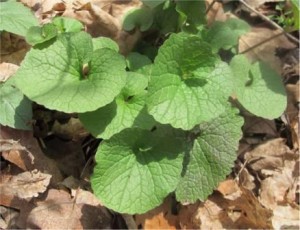Garlic Mustard (Alliaria petiolata)
Garlic mustard is a naturalized European biennial herb that typically invades partially shaded forested and roadside areas. It is capable of dominating the ground layer and excluding other herbaceous species. Its seeds germinate in early spring and it develops into a basal rosette during the first year. Garlic mustard produces white flowers between late April and June of the following spring. Plants die after producing seeds, which typically mature and disperse in August. Normally its seeds are dormant for 20 months and germinate the second spring after being formed. Seeds remain viable for up to 5 years.
A. Hand Pulling:
Hand pulling is an effective method for removing small populations of garlic mustard, since plants pull up easily in most forested habitats. Plants can be pulled during most of the year. However, if plants have capsules present, they should be bagged and disposed of to prevent seed dispersal. Care should be taken to minimize soil disturbance but to remove all root tissues. Soil disturbance can bring garlic mustard seeds to the surface, thus creating a favorable environment for their germination. To avoid this, soil should be tamped down firmly after removing the plant. Re-sprouting is uncommon but may occur from mature plants not entirely removed.
B. Cutting:
Cutting is effective for medium- to large-sized populations depending on available time and labor resources. Cut stems when in flower (late spring/early summer) at ground level either manually (with clippers or a scythe) or with a motorized string trimmer. This technique will result in almost total mortality of existing plants and will minimize re-sprouting. Dormant seeds in the soil are unaffected by this technique due to minimal disturbance of the soil. However, as viable seeds may be produced from cut stems, they should be removed from the site when possible. Cuttings should be conducted annually until the seedbank is depleted.
C. Prescribed Fire:
In fire-tolerant communities, fall or early spring-prescribed burning can be an effective means of controlling garlic mustard. All applicable permits and licenses must be obtained prior to conducting a controlled burn. Mid-intensity spring burns appear to reduce density of adult plants somewhat more effectively than fall burns. Burning must be repeated in at least two consecutive years and must burn through the entire affected area to ensure adequate control and to eliminate plants produced from the seed bank. Isolated plants not affected by burning should be removed by hand prior to flowering.
D. Herbicides:
Garlic mustard is a biennial that spreads only by seed. The postemergence herbicides listed below should be applied after seedlings have emerged, but prior to flowering of second-year plants. None of these herbicides will affect subsequent seedling emergence of garlic mustard or other plants.
SAFER Superfast Weed & Grass Killer [potassium salts of fatty acids]: Ready-to-use spray
FINALE [glufosinate-ammonium (11.33%)]: 3 fl. oz./gal
ROUNDUP [glyphosate (41%)]: 1.25 fl. oz./gal
References
Nuzzo, V., J. Kennay, and G. Fell. 1991. Vegetation management guideline: Garlic Mustard, Alliaria petiolata (M. Bieb.) Cavara & Grande. Natural Areas Journal 11(2): 120-122.
Nuzzo, V. 1994. Element Stewardship Abstract for Alliaria petiolata (Alliaria officinalis), Garlic Mustard. The Nature Conservancy.
Tennessee Exotic Plant Management Manual, April 1997.
